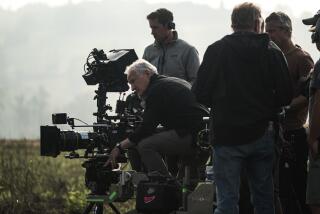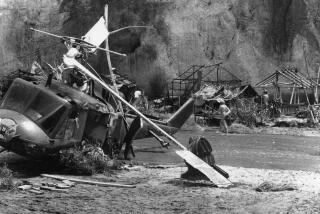We can’t help but gawk at the Ferrari wreck
- Share via
Perhaps not since O.J. Simpson’s low-speed freeway chase has a vehicle crashed so hard into the imagination of Los Angeles.
Early one morning in February, Bo Stefan Eriksson went for a spin through Malibu in a $1-million Ferrari Enzo and wound up on a collision course with much more than just that Pacific Coast Highway telephone pole that the car hit at 162 mph.
There’s already the commemorative T-shirt to prove it: A graphic of the demolished Ferrari is on the front, with “... Dietrich?” in Gothic font on the back. Eric Bauer, 32, a digital model builder who lives in the San Gabriel Valley, is selling them through his website, www.ericgbauer.com.
In case you’ve been out of town: The crash snapped the highly coveted Ferrari, one of only 400 Enzos made, into two pieces, leaving a 1,200-foot debris trail on the road. Eriksson walked away with only a bloody lip while, he claimed, a mysterious German named Dietrich, who had been behind the wheel at point of impact, ran off into the hills, never to be seen again.
Almost immediately, the questions began: How could he come out of a wreck like that virtually unscathed? Did it happen, as rumored, during a race with a black Mercedes-Benz SLR? Who were those shadowy men who identified themselves as Homeland Security Department officials reportedly snooping around the scene? How could someone with a checkered past like Eriksson’s become a badge-carrying member of a private police force?
And, most tantalizingly, who is Dietrich? In the annals of car-culture sob stories, Eriksson’s version of events ranks somewhere between Eddie Murphy’s explanation for giving a transsexual prostitute a lift down Santa Monica Boulevard in 1997 -- the comedian was “simply trying to be a good Samaritan” -- and Britney Spears’ for driving on PCH with her then 5-month-old son in her lap: a “horrifying, frightful encounter” with paparazzi.
If the basic facts of the accident weren’t strange enough already, “Enzogate” has grown steadily more bizarre, with weekly revelations about mystery guns, yacht raids and Swedish mafia tie-ins.
“The Malibu Ferrari crash, she will not die,” read a posting on the fishbowlLA website last week.
Eriksson himself is part Steve McQueen, part Chris Farley; the Swedish national comes off as a dashing cad and international man of mystery, but also a doofus -- a guy living large enough to keep not one but two Ferrari Enzos in the garage of his Bel-Air compound (even if they were brought into the country illegally and actually belonged to British banking institutions), but lacking enough sense to avoid driving at mach speed (with or without the German) allegedly after a few too many cocktails. Or, for that matter, enough sense to keep his mouth shut until his lawyer arrived.
Eriksson has been charged with crashing the car while drunk and ordered to stand trial on a pileup of felony counts, including embezzlement, grand theft auto and gun possession, that could result in up to 14 years in prison. He has pleaded not guilty.
“As someone who covers the industry, I’m just waiting for this guy’s life to become a screenplay,” said Tatiana Siegel, a film reporter for the Hollywood Reporter, who has been avidly following the crash and its aftermath. “It has all the elements you want in a story. It just seems so perfect.”
Or, as Kevin Roderick, editor of the LA Observed website, sees it, the Ferrari crash is a perfect storm of Los Angeles stories.
“It happened in Malibu, which means stars. It’s cars, such an innately L.A. thing. It’s a miracle the guy would survive a crash like that,” Roderick said. “And then on top of it, there’s all the bizarreness: He’s got the guy who supposedly smashed the car running into the hills.”
Ah, Dietrich. “What I think gets everyone is this, ‘Oh, I met a strange German at a party in Beverly Hills, we got drunk and I thought it would be a good idea to have him drive my car around -- then he crashed it and ran,’ ” Bauer said. “I couldn’t just sit back. I had to do something. I had to make this shirt.”
Eriksson, Bauer said, “set a precedent. Next time I get pulled over, I’m going to jump into the passenger seat and say, ‘Wasn’t me. I wasn’t driving. It was Dietrich. And he ran off.’ ”
It’s hard not to think of the speech Don Cheadle’s character delivers about Angeleno inter-connectivity at the outset of the movie “Crash”: “We crash into each other” -- or, in this case, roadside utilities -- “just so we can feel something.”
Gearheads, it should be noted, despair about the car itself and hate Eriksson. The Enzo represents the pinnacle of high-performance street technology -- a futuristic-looking carbon-fiber road rocket capable of topping out at 218 mph with a V12 engine modeled on those in Ferrari’s Formula One racers. According to Enzo lore, for every person who managed to get ahold of one of the coveted cars (excluding Pope John Paul II, who received one as a ceremonial gift -- and presumably never drove it), there were at least three others with as much money and white line fever.
“This rich baller wraps his Enzo around a telephone pole at 160 and walks away -- if it’s coming up every day in normal circles, it’s coming up 10 times a day in car circles,” said John Cannizzo of Huntington Beach, a director on the board of the Ferrari Owners Club. “How can this car be so well made that the only injury is from the air bag? I hear about it constantly.”
Or, as a police officer at the scene of the accident put it, “For a million dollars, you get a pretty good air bag system.”
But even if the car side of the crash has quickly turned to legend, its back story is playing out like some tragi-comic version of “The Talented Mr. Ripley.” Eriksson, it turns out, has a criminal past: a former video game impresario for the European company Gizmondo -- a highly touted GameBoy knockoff that filed for bankruptcy earlier this year with more than $200 million in debt -- known as “Tjock-Steffe” or Fat Steve in his homeland, he spent five years in Swedish prison for counterfeiting, assault and narcotics offenses.
Scandinavian newspapers paint him as having Swedish underworld ties. But up until the accident, Eriksson seemed intent to put “Tjock-Steffe” behind him and create a new life in L.A.
“You’ve got a Ferrari involved in this bizarre thing,” said KTLA-TV news reporter Bill Smith, who was with the first TV crew at the accident site, “and if that’s not enough, the guy turns out to be as bizarre as the crash.”
As the thinking goes, if he hadn’t crashed, police might never have found out about any of his dealings. Not the .357 Magnum Smith & Wesson belonging to an Orange County reserve sheriff’s deputy that somehow wound up in Eriksson’s house and was later confiscated. Not the cache of illegal weapons police found on Eriksson’s buddy’s yacht. Not Eriksson’s connection to the San Gabriel Valley Transit Authority, a tiny, private organization providing rides for elderly and disabled people, which gave Eriksson a card identifying him as a “deputy police commissioner.” Who knew a transit company could legally create its own private police department?
“The Ferrari thing has this element of, ‘Oh, so this is what rich people do with their money,’ ” said Siegel. “For people who aren’t incredibly wealthy, it’s like, ‘I figured that rich people don’t take care of their things very well.’ And for wealthy people, it’s fascinating because it’s like someone taking a Van Gogh painting and pummeling it.”
According to KTLA’s Smith, who crisscrosses the Southland numerous times each week doing live remote broadcasts, interest in the Ferrari mystery has remained as constant as “American Idol” ratings since February.
“Most of our feedback has been in the field,” he said. “Wherever we are, people come up to the live truck asking about it. They begin conversations, ‘Were you the guys at the Ferrari? Did you see the Ferrari?’ ”
Eriksson is scheduled to stand trial May 15. But even before Enzogate gets its day in court, where “Perry Mason” moments and new plot developments seem all but inevitable, the question must be raised: When will Ferrari fatigue begin to settle in?
“There is no substantive issue here, there’s no societal imperative at all,” said LA Observed’s Roderick. “And I keep waiting for it to turn out to be less than what meets the eye; I keep wanting to let it die. But it won’t. And I’m running out of ways to wink at it: ‘This is a lame story, but here. Here’s another twist.’ ”







